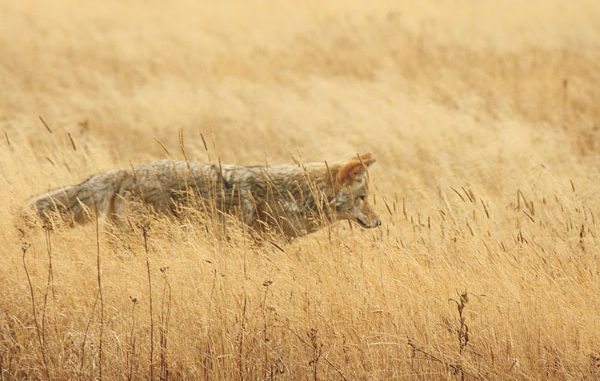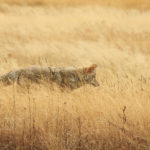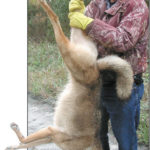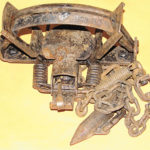
Coyotes as a predator may be a problem for big-game hunters, but they also offer the opportunity for some year-round hunting.
South Carolina’s statewide deer population has declined by about one-third since the mid-1990s. Habitat change, development and pine plantation monocultures have contributed, but a factor that parallels the drop in the deer population is the increase in the coyote population.
Hunters and wildlife managers have become increasingly concerned about the effects of coyote predation on fawns. To better understand the situation’s dynamics, a 3-year study was conducted at the Savannah River Site to document what is happening, funded by the U.S. Forest Service and the S.C. Department of Natural Resources, the latter with revenue generated by the sale of doe tags.
Charles Ruth, an SCDNR biologist who supervises the deer and turkey projects, discussed the results last November, revealing that 70 percent of all fawns were lost annually due to mortality, and coyotes were responsible for 80 percent of that mortality. Ruth said that previously, biologists pegged the ratio of does to surviving fawns at one-to-one. The SRS study indicates that three does are required to get one fawn into the adult population.
A Georgia study showed that coyote scat contained double the percentage of deer hair during fawning season, and a study in a suburban area outside Auburn, Ala., found that coyote predation was the primary cause of fawn mortality.
The second phase of the SRS study, begun in January 2010, showed that by reducing the coyote population on the 20,000-acre study site, the rate of faw survival doubled.
How to manage the coyote problem depends on habitat, location and hunting pressure, among other factors.
The best way to control the coyote population is by trapping. Since trapping is not allowed on public lands, a reduction in the doe harvest may be required to offset the loss to coyote predation. On private land, trapping is permitted, but requires an ongoing dedication by the landowner. If trapping is not continued from season to season, coyotes in surrounding area will expand their ranges and replace the diminished population — particularly true on properties with small acreage.
In urban areas where hunting is not allowed or is limited, coyotes may not be a problem because they provide a natural method of controlling the deer population. That results in fewer deer/auto collisions, crop predation, destruction of ornamental plants and other negatives associated with too many deer in an urban or suburban setting.
On public Wildlife Management Areas, it may be necessary to limit or discontinue doe harvest to offset predation by coyotes, which may not be popular with hunters who have enjoyed the option of harvesting does.
The decision concerning doe harvest will require monitoring the population across the state. “One size” does not fit all; it will require tailoring limits to specific areas to keep deer populations at desirable levels, Ruth indicated.
Coyotes are adaptable and can survive under widely varied conditions. They have a diverse diet, including plant material, garbage, insects, small mammals, carrion and any number of food items. In late spring and summer, fruit is the No. 1 food source. In the winter and early spring, an increase in live prey takes place. Fawns have become an important food source during the spring and early summer.
Coyotes average 28.5 pounds across South Carolina, meaning they can easily take down fawns or other small animals, and reports of attacks on livestock have increased as the coyote population has grown.
Chip Sharpe of Natural Resource Specialties is a former employee of SCDNR now involved in providing services to landowners to control nuisance animal populations. He not only will trap coyotes, he will train landowners or managers to trap them, and he’ll supply a complete trapping package.
According to Sharpe, coyotes are resourceful and have keen noses. It is critical to practice good scent control with traps, clothing and boots when trapping. Foothold, coil-spring traps must not exceed 5.75 inches inside jaw spread. Snares are not allowed for land sets, and box or cage traps are not usually successful for coyotes.
During the 2010-11 season, hunters in South Carolina took around 30,000 coyotes, which appears a large number but is only a small percentage of the total coyote population. were taken by hunters. While the number seems large, it is only a small percentage of the total population. Hunting and trapping can reduce or control the coyote population but should not be looked at as a plan for eradication.
A deer’s danger zone
The risk of coyote predation on whitetail fawns is greatest during the first month of a fawn’s life. As they reach four to six weeks of age, they are better able to evade predators, so trapping and predator control just before the fawning period is most productive in minimizing losses. In the Savannah River Site study, no fawns were killed by coyotes after they reached 10 weeks old.
This parallels the experience in North Carolina, where elk were transplanted into the Great Smoky Mountains National Park. Black bears learned to prey on elk calves, and the elk population did not increase as rapidly as expected. Biologists experimented by trapping and transporting bears to other areas just before calving season, and even though many of the bears returned to the area at a later date, the elk calves had more time to reach the age where they were less vulnerable. The result was that losses were reduced significantly.






Be the first to comment